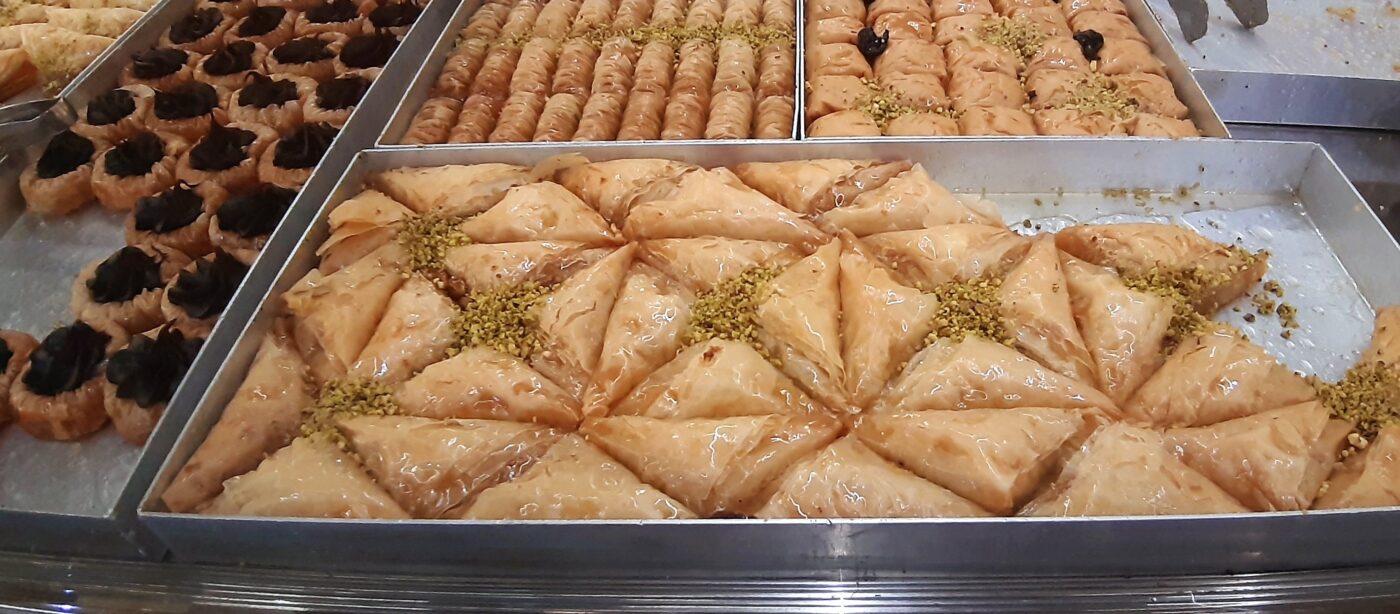Greece, Greek cuisine
Siropiasta – Greek Desserts With Syrup
Greek cuisine is very popular, but it is better known for its main dishes or appetizers rather than its desserts or sweets, which are plenty and delightful.
Here we’re going to look into one of the Greek dessert categories, “the siropiasta”.
For extra photos, click here to look at the photo album
The siropiasta take their name from the word σιρόπι (en. syrup), because all these desserts are doused with syrup after baking, which makes them moist, sticky and delicious. Each household and baker have their own syrup recipe depending on how they sweet and aromatic they want their desserts to be, but most recipes include water, granulated sugar, maybe a little bit of honey, lemon zest and a cinnamon stick.
The majority of the siropiasta are baked in the oven in large, round metallic trays, consist of some type of nut and can be served with fresh vanilla or kaimaki (gr. καϊμάκι) ice cream.
Baklavas
Baklavas is a layered pastry dessert made of filo pastry. It’s filled with chopped nuts and sweetened with syrup or honey. Baklavas (or baklava) is a common dessert of many cuisines, including the Greek, Iranian, Turkish and Arab ones. While we cannot be sure where this dessert originates from, according to one of the most likely theories about its origin is that it was developed in the imperial kitchens of the Topkapi Palace in Constantinople (Istanbul). In Greece, we traditionally make baklavas with chopped pistachios or walnuts.
Saragli
It is a variation of baklava. We can use the same filling of chopped nuts but instead of layering the filo pastry, we spread it out, add some filling at one end and then roll it up.
Kadaifi
Kadaifi, alongside baklava, is one of the most popular Greek desserts and is made with a special pastry dough that consists of thread-like strands (like angel hair pasta). When making kadaifi, we spread out the dough, place some filling at one end and then roll up the dough until we have a nice, even roll. In a pan, we place the little rolls snuggly next to each other and bake them until golden-brown and crispy. An important note for all siropiasta is, that for the syrup to be distributed evenly and soak the dough throughout without making it soggy, we need to make sure that the dessert is cold and the syrup piping hot or vice versa.
After the kadaifi has cooled down a bit, simple syrup is poured over it. Similar to baklava, it can be filled with chopped walnuts, almonds and other nuts, and scented with ground clove, cinnamon, and lemon zest.
Ekmek
Ekmek is another mouth-watering Greek dessert which is made with layers of kadaifi dough baked until crispy, bathed in syrup and topped with a thick layer of rich, velvety custard cream and another layer of whipped cream, then sprinkled with crushed pistachios on top. It’s very indulgent but worth the effort and the time. Ekmek is often served with kaimaki ice cream, which takes its taste from salep and mastic.
Diples
Diples, or Greek honey rolls, are considered a seasonal dessert, because they’re usually made around Christmas. They originate from the town of Kalamata in Peloponnese, South Greece, where they are also served in engagement and wedding parties, baptisms and other social celebrations. Their name comes from the Greek word for “fold” (gr. δίπλα, διπλώνω – the Greek verb “to fold”), which is a very accurate way to describe them since they look like dough that has been folded. The little ‘packages’ of dough are fried until crispy and drizzled with honey and dusted with cinnamon and ground walnuts.
Galaktoboureko
Galaktoboureko is a Greek, Turkish, and Syrian dessert of semolina custard baked between two layers of filo dough and bathed in syrup. The custard filling is made with eggs, granulated sugar, heavy cream, milk, butter and semolina. It’s a very rich, moreish dessert with a strong fan base. The word galaktoboureko derives from the Greek word for milk, gala (gr. γάλα).
Ravani
Ravani, which is also called revani, is a sweet semolina cake doused with syrup – we know by now that Greeks love syrup in their desserts! There are variations of this cake in Turkish and Egyptian cuisine as well. Some bakers flavour their syrup with rose water, orange or lemon zest. For a tasty and more exotic twist to the traditional receipt, one can also add finely shredded coconut to the mix.
+++++++++++++++++++++++++++++
Do you also have a sweet tooth, and would like to taste all those amazing deserts? Then you are welcome in Greece, where you can find those sweets in all sizes in most of the pastry shops around the country.
Pastry shops in Greece usually remain open till very late every day (10-11 pm), so you can get them fresh any day.
Of course, a pastry shop sells many other things as well – the options are endless! If you want to learn about all the things that you can buy in a bakery and a pastry shop, and how to order them in Greek, take a look at our multi-video lesson ‘The Greek Bakery and Pastry Shop’. It explains how to pronounce their names correctly and how to tell them apart; the lesson includes an eBook, audio and video.
Click here —-> https://masaresi.com/product/greeklesson-bakery/

